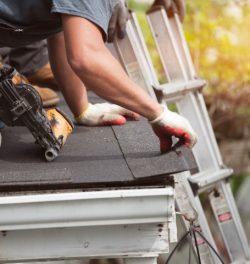DIY Projects You Should Never Do Yourself
December 10, 2021
8 Home Improvements You Should Never DIY
With a decent set of tools, a little bit of know-how and a healthy dose of courage, some DIY can save money and earn bragging rights by handling tough home renovation jobs themselves.
Some house renovation work, however, is best left to the pros — and in some cases, the law demands it. Others are simply too dangerous or too complex for the average person to perform.
As a rule of thumb, remodeling work that could potentially end with homeowners blowing up, burning, crushing, zapping or poisoning themselves, their neighbors or their houses should be handled by the experts. Take a look at the home improvement projects you should consider hiring someone to handle.
Converting Ovens and Cooktops From Electric to Gas

You can definitely clean your oven with some DIY cleaners, but only licensed contractors are permitted to install natural gas equipment, according to Consolidated Edison. The job requires work with both complicated gas and electrical systems and might involve converting electrical components from 240 volts to 120 volts, capping gas lines, converting two-pole circuit breakers to single-pole breakers, and both tapping into existing gas lines and running new ones. This is over the heads of most do-it-yourself amateurs, even if licensed professionals weren’t required by law to do the job, which they are.
Replacing Hot Water Heaters
Replacing, removing, installing and moving hot water heaters is home repair work that requires licensed professionals to obtain permits. When permits are involved, this is one extra renovation expense you don’t want to cut corners on. Another aspect of this complex; difficult and potentially dangerous work deals with achieving proper ventilation, temperature control and pressure control. DIYers risk not only reduced efficiency through mishaps like incorrectly installed insulation, but there’s also a risk of fire, explosion, leaks and exposure to gas fumes.
Demolishing a Wall

Some walls exist only for cosmetic purposes. Others partition open spaces into rooms or conceal necessary systems. Load-bearing walls; on the other hand, are critical to the structural integrity of your home, and if you want your renovations to pay off, you need to be careful before making them. If you want to remodel, such as moving to an open floor plan, remember that it’s not always clear which walls serve as critical supporting structures and which ones don’t. Also, it’s hard to tell what’s behind a wall; and even if you can definitively say that the wall you want to remove isn’t load-bearing, it’s likely that demolition requires a permit either way.
Asbestos Removal
Asbestos has been definitively linked to lung disease and some cancers. Modern builders don’t use it, but the strong, fire-retardant material was a common component in building materials for generations. If you have an older home; it’s possible to find asbestos on siding or roof shingles; hot water pipes or steam pipes, or in wall and attic insulation. This is not among the DIY projects you want to — or are allowed to — attempt on your own. Not only shouldn’t you try to remove asbestos by yourself; according to the Environmental Protection Agency, but you also shouldn’t even disturb materials you suspect of being asbestos for testing purposes.
Lead Removal
Like asbestos, lead was, but no longer is, commonly used in building materials. The EPA issues strict regulations — and Congress has passed a wave of legislation — dealing with how lead must be removed, handled and discarded. Lead can be found in water, soil and even in the air; but homeowners are most likely to encounter it in paint applied years ago in older houses. This is not a do-it-yourself project.
Cutting Down Large Trees
Most localities require homeowners to get permits to cut down trees — and for good reason. If you don’t know what you’re doing, it’s likely that branches, limbs or even an entire tree can come crashing down on your house; your neighbor’s house or anything else in the area. If utility poles are near, so is the risk of electrocution. Finally, when it comes to cutting down trees, the tools themselves are dangerous.
Removing a Water or Fuel-Storage Tank
Maybe you recently switched from oil to gas and you want to save money by removing the old tank yourself. In other cases, a leak in an old fuel tank from a previous system might require action that you don’t want to pay for. Sorry, but this isn’t something you can remodel on your own. The environmental hazards associated with the removal and disposal of fuel containers has forced local; state and federal regulators to preclude weekend some DIY from removing them.
Roof Repair
 Your roof is one of the most critical and expensive systems in your entire home — and it’s almost never a place for DIYers to try to save a buck. The obvious danger of falling is coupled with the fact that roof work is complicated. Also, it’s likely that you won’t even be able to identify the source of the original problem, much less fix it correctly. Laws require a permit for any work that changes your home’s roofline; but even though other repair jobs don’t require a permit; attempting to do roof work yourself without hiring a professional is likely to void your roof’s warranty.
Your roof is one of the most critical and expensive systems in your entire home — and it’s almost never a place for DIYers to try to save a buck. The obvious danger of falling is coupled with the fact that roof work is complicated. Also, it’s likely that you won’t even be able to identify the source of the original problem, much less fix it correctly. Laws require a permit for any work that changes your home’s roofline; but even though other repair jobs don’t require a permit; attempting to do roof work yourself without hiring a professional is likely to void your roof’s warranty.
Installing a Skylight
Roof penetrations, such as the kind needed to install skylights, usually require a permit to create — and it’s a job that’s easy to mess up, even for the some handiest DIY.
Not only does installation require gouging a precision hole in the roof and then resealing it with expert waterproofing; but the job might involve cutting into a truss; maneuvering around wiring and HVAC equipment in the attic and building a framed tunnel called a chase.
Skyway Home Improvement is a construction company located in New Jersey. We are fast and our goal is to provide a service that exceeds clients’ expectation. Contact us on Facebook.
